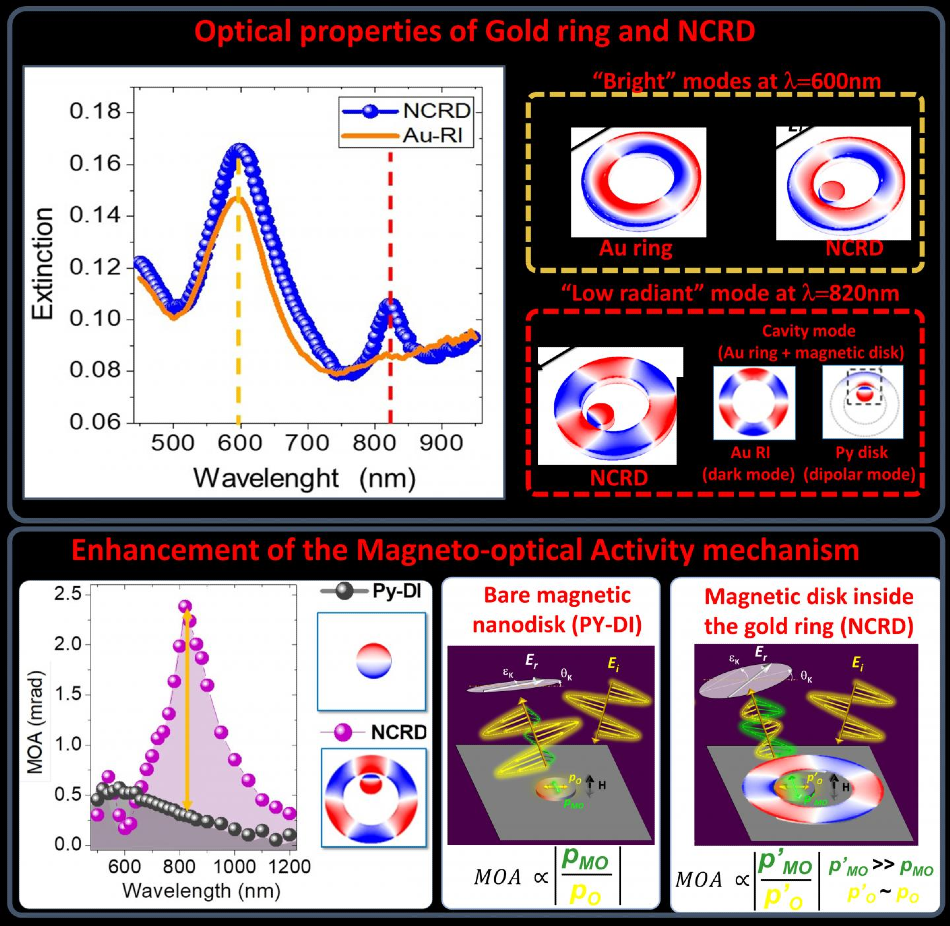Jun 3 2020
In the field of nanophotonics, the polarization of light is used as an information carrier for optical communications, imaging, and sensing. Similarly, for the photonic transfer of quantum information, the light polarization state plays a crucial role.
 Sketch of the electrodynamics of the bare magnetic permalloy disk (Py-DI) generating an electric dipole (pO) triggered by the electric field Ei of an incident linearly polarized electromagnetic radiation and a magneto-optically activated electric dipole (pMO) by a magnetic field H. Image Credit: Alberto López-Ortega, Mario Zapata-Herrera, Nicolò Maccaferri, Matteo Pancaldi, Mikel Garcia, Andrey Chuvilin, and Paolo Vavassori.
Sketch of the electrodynamics of the bare magnetic permalloy disk (Py-DI) generating an electric dipole (pO) triggered by the electric field Ei of an incident linearly polarized electromagnetic radiation and a magneto-optically activated electric dipole (pMO) by a magnetic field H. Image Credit: Alberto López-Ortega, Mario Zapata-Herrera, Nicolò Maccaferri, Matteo Pancaldi, Mikel Garcia, Andrey Chuvilin, and Paolo Vavassori.
In this context, for future nanophotonic applications, optical nanodevices that allow dynamic manipulation of the nanoscale polarization of light are vital components.
Magnetic materials show what is called the magneto-optical (MO) activity, which arises from spin-orbit coupling of electrons, leading to a weak magnetic-field-induced intensity and polarization modulation of transmitted and reflected light (in the order of mrads).
The field of magneto-plasmonics involves exploring metamaterials and nanostructures that integrate the strong local improvements of electromagnetic fields generated by localized plasmon excitations—or collective oscillations of the quasi-free electrons—with the magnetic constituent’s intrinsic MO activity to improve the otherwise weak magnetic-field-induced polarization modulation.
A majority of the studies on magneto-plasmonics to date have dealt with the excitation of bright (or radiant) localized dipolar plasmonic resonances, called LPRs, for the amplification of the MO response. Dimeric, multilayered hybrid noble/ferromagnetic metal structures and purely ferromagnetic nanoantennae have, in fact, exhibit the feasibility to control and amplify the MO properties through plasmonic excitations.
In the archetypical example of a circular disk-like magneto-plasmonic nanoantenna, an LPR is excited by incident radiation of proper wavelength. Upon “activation” of the nanoantenna by a magnetic-field (H), the inherent MO activity induces a second LPR. The LPR drives this MO-induced LPR (or MOLPR) in a direction orthogonal to both the LPR and H.
The ratio between the LPR and the MOLPR is proportional to the ratio between the response of orthogonal radiating electric dipoles governing the magnetic-field-induced change in the polarization of re-emitted light. But a parallel improvement of the electric dipole associated with the LPR causes the synthesis of a large MO-induced electric dipole associated with the MOLPR.
The excitation of the LPR, radiating light with the incident polarization, at the same time as the MOLPR, radiating light that has a polarization orthogonal to that of the incident radiation, restricts the maximum realizable improvement of magnetic-field-induced variation in the polarization of transmitted and reflected light.
With this MO enhancement limitation using bright dipolar resonances, it has been possible to experimentally observe amplifications of only up to about 1-order of magnitude of the MO response. This is not sufficient for practical applications of magneto-plasmonics to active flat-optics and nanophotonics.
An international research team led by the Nanoscience Cooperative Research Center, CIC Nanogune, Spain, describes a new study in Light: Science & Application, which proposes and demonstrates an approach to resolve the above-mentioned limitation.
The solution involves using excitation of the hybrid high-order multi-polar dark modes as a robust and viable approach to amplify the magneto-optical activity of magneto-plasmonic nanoantennas, thus achieving an unmatched active control of the polarization of light under a magnetic field.
The researchers developed symmetry-broken non-concentric magneto-plasmonic-disk/plasmonic-ring nanostructures to allow the free-space light excitation of multipolar dark modes in the plasmonic-ring and hybridizing them with the dipolar plasmonic resonance of the magneto-plasmonic disk, thus resulting in a hybrid multipolar mode.
The huge amplification of the MO response of the new nanocavity was achieved through a strongly optimized radiant MOLPR, induced by the low-radiant hybrid multipolar resonance rather than a bright LPR. Thus, the researchers achieved the amplification of the radiated light from the strongly amplified MO response, thereby preventing a concurrent large improvement of radiated light with the incident polarization.
Journal Reference:
López-Ortega, A., et al. (2020) Enhanced magnetic modulation of light polarization exploiting hybridization with multipolar dark plasmons in magnetoplasmonic nanocavities. Light: Science & Applications. doi.org/10.1038/s41377-020-0285-0.